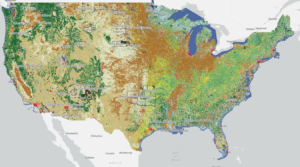ARMP-IRMP Planning Portal
Climate Resources
Find here the key data to fill in the Climate Section of your ARMP and IRMP. Refer back to the templates located on the Getting Started page for more details.

Soil Salinity in U.S. Native Lands
This map displays soil salinity data layers derived from the Harmonized World Soil Database (HWSD) Global Soil Quality – Constraints due to Excess Salts (HWSD Excess Salts). This Soil Salinity data on US Native Lands is presented here as a potential resource for Tribes to use in natural resource and climate adaptation assessment and planning.

Change in Rain & Snow Patterns on U.S. Native Lands
This map displays data layers based on the EPA’s Climate Change Indicators in the United States report, specifically focusing on Change in Rain & Snow Patterns on U.S. Native lands. On this map, view layers related to change in snowfall, precipitation, snow-to-precipitation ratio, and April snowpack in western US.

Temperature Change Patterns on U.S. Native Lands
This map displays data layers based on the EPA’s Climate Change Indicators in the United States report, specifically focusing on Temperature Change Patterns on U.S. Native lands. On this map, view layers related to annual average air temperatures, unusually hot temperatures, and unusually low temperatures.

US Drought Monitor (Google Earth Engine)
This map displays US Drought Conditions updated every Thursday as reported by National Drought Mitigation Center (NDMC)

Thermal Activity on US Native Lands
This map shows satellite detected hotspots and wildfire activity provided by federal, state, and local agencies.

Intact Habitat on US Native Lands
This layer represents modeled Intact Habitat Cores, or minimally disturbed natural areas at least 100 acres in size and greater than 200 meters wide.

Intact Habitat Selector Tool
Explore and filter a national database of intact landscape cores to identify important habitat your tribe seeks to protect based on species richness, water availability, landscape variability, soils, etc.

National Land Cover Database: Tribal Lands Viewer
This map viewer visualizes every available year of the National Land Cover Database (NLCD) and makes it possible to filter for 848 native land areas (reservations and off reservation trust lands) in the United States for 2001 and 2019.

ESRI Landsat Explorer
Esri Landsat Explorer app provides the power of Landsat satellites, which gather data beyond what the eye can see. Use this app to draw on Landsat’s different bands to better explore the planet’s geology, vegetation, agriculture, and cities. Additionally, access Landsat imagery from the last forty years to visualize how the Earth’s surface has changed over time.

Available Water in Soil on US Native Lands
About this Dashboard This dashboard features a reservation-level view of the available water data in soil on all tribal lands in the US. Data comes

Average Wind Speed on US Native Lands
About this Dashboard This interactive dashboard provides a comprehensive analysis of average wind speed patterns across tribal lands in North America, using data from the

Precipitation Projections and Winter Trends on US Native Lands
About this Dashboard This data dashboard summarizes data from future precipitation predictions and historical changes in the snow-to-precipitation ratio on Tribal lands in the contiguous

Extent of Fires on US Native Lands
About this Dashboard This data dashboard summarizes data from the Monitoring Trends in Burn Severity (MTBS) Dataset, which the USGS EROS and the United States

Renewable Energy Production on US Native Lands
About this Dashboard This dashboard features current renewable energy production (wind, solar, biomass, and hydroelectric) on US Native Lands. It combines data from two sources:

Environmental Risks for US Native Lands (Drought, Heat, Rain, Wildfire: 1980-2020)
About this Dashboard This dashboard shows key environmental risks data for US tribal lands to help tribes monitor and assess risks and incorporate them in

Conservation Reserve Program
About this Dashboard This data dashboard summarizes data from the USDA FSA conservation reserve program (CRP) for every eligible county in the United States since

Soil Organic Carbon for Land Planning on Native Lands
About this Dashboard This data dashboard summarizes past and present Soil Organic Carbon (SOC) data for all Native Lands but also future estimates depending on

USDA Census of Agriculture for American Indian Reservations
About this Dashboard This dashboard was developed by the Native Lands Advocacy Project to make data from the 2007, 2012, 2017, and 2022 USDA Census of
